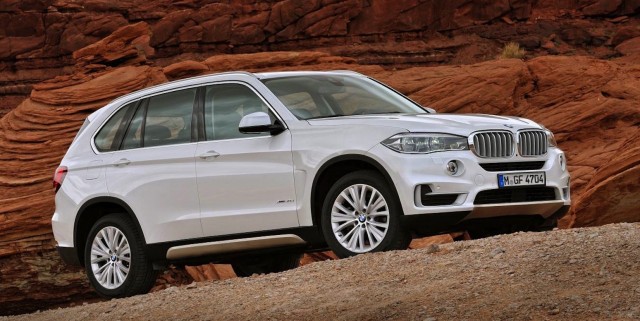The all-new BMW X5 will be available with both rear-wheel drive and a four-cylinder diesel engine for the first time, highlighting the German manufacturer’s pursuit of greater efficiency and affordability from its next-generation full-size SUV.

The larger, more versatile and more luxurious third-generation BMW X5 is set to make its public debut in Frankfurt in September, before going on sale in Australia during the final quarter of 2013.
New to the range is the BMW X5 sDrive25d – the first non-all-wheel-drive model in the nameplate’s 14-year history. BMW claims the 160kW 2.0-litre four-cylinder diesel-powered rear-driver will consume just 5.6 litres of fuel per 100km on the combined cycle and emit 149 grams of CO2 per kilometre, making it just 0.3L/100km thirstier than a 520d wagon.
The sDrive25d will be part of a second wave of engine variants introduced in December 2013 after the X5’s initial third-quarter launch. Joining the base diesel at the end of the year will be the 225kW xDrive35i, 230kW xDrive40d, and an all-wheel-drive version of the 25d.
BMW Australia corporate communications general manager Lenore Fletcher said the rear-wheel-drive X5 was “definitely of interest” to the local division, which is currently finalising its line-up.
“Given the huge increase in the popularity of SUVs, particularly two-wheel drives … naturally that’s going to be of interest to us,” Fletcher said.
The initial launch line-up will comprise three engines: a mid-spec diesel, a high-end petrol, and a triple-turbo M Performance diesel.
Power and torque from the X5 xDrive30d’s 3.0-litre inline six-cylinder diesel engine increase 10kW and 20Nm respectively to 190kW/560Nm. Accelerating from 0-100km/h is now seven-tenths quicker at 6.9sec, yet fuel consumption also falls 16 per cent to 6.2L/100km.
The X5 xDrive50i’s twin-turbocharged 4.4-litre V8 has also been beefed up 30kW/50Nm for peak outputs of 330kW and 650Nm. The 50i wipes half a second off its predecessor’s sprint time (now 5.0sec), yet fuel consumption falls 2.0L/100km to 10.4 and CO2 emissions drop 50g/km to 242.
The 280kW/740Nm triple-turbocharged 3.0-litre straight-six diesel carries over unchanged into the X5 M50d, though improvements in other areas help shave one-tenth off its sprint time (5.3sec) and 11 per cent from its economy rating (6.7L/100km).
BMW says every engine variant in the third-gen X5 family satisfies Euro 6 emissions regulations, which don’t come into effect in Europe until September 2014.
At 4886mm long, 1938mm wide, 1762mm tall, the all-new BMW X5 is 29mm longer, 5mm wider and has a 4mm-lower roofline than the second-gen luxury SUV. The 2933mm wheelbase has been retained.
Boot capacity is up 30 litres to 650L, and the second-row seats can now be split 40:20:40 to create 1870L of space (up 120L).
All X5 grades adopt BMW’s ‘Drive Experience Control’ switch, allowing drivers to select between Eco Pro, Comfort, Sport and Sport+ modes to optimise the characteristics of the accelerator, eight-speed automatic transmission, power steering, and – where the Adaptive Suspension option has been specified – the dampers and anti-roll bars.
There are few surprises in the X5’s new exterior styling, where it embraces the integrated headlight and kidney grille design language that debuted on the 3 Series. Large L-shaped LED-imbued tail-lights dominate the rear, while assertive bumpers and deep panel contours combine to create a muscular yet sophisticated body.
A freestanding 10.25-inch screen dominates the dashboard and teams with the iDrive controller to facilitate access to the car’s climate, infotainment and vehicle set-up functions. Horizontal dash lines and a compact centre stack enhance the cabin’s sense of spaciousness, contributing to a conservative but clean layout.
BMW’s Traffic Jam Assistant headlines the new X5’s extensive list of driver-assist technologies. Available from December, the system takes control of the throttle, brakes and steering at up to 40km/h, to drive the car without requiring any input from the person behind the wheel.
The autonomous technology extends to the Parking Assistant system, where the car can park itself in parallel and perpendicular spaces with no input from the driver.
Other features include adaptive LED headlights, night vision with dynamic light spot function, emergency call system, head-up display, speed limit information, surround view camera assistance and real-time traffic information.
The BMW Apps option includes web radio, Facebook and Twitter access, while ticking the Online Entertainment Box provides access to around 12 million music tracks.
The third-generation BMW X5 will be produced at the German company’s Spartanburg plant in South Carolina, USA.





